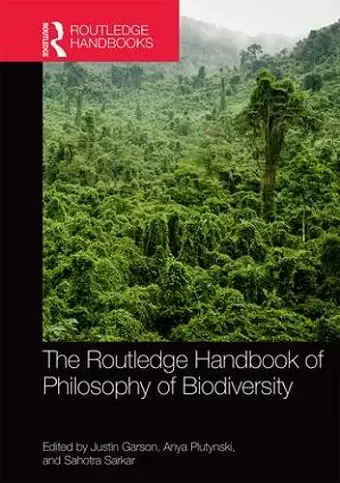The Routledge Handbook of Philosophy of Biodiversity
Sahotra Sarkar editor Justin Garson editor Anya Plutynski editor
Format:Hardback
Publisher:Taylor & Francis Ltd
Published:30th Sep '16
Currently unavailable, and unfortunately no date known when it will be back
This hardback is available in another edition too:
- Paperback£48.99(9780367370497)

Biological diversity - or ‘biodiversity’ - is the degree of variation of life within an ecosystem. It is a relatively new topic of study but has grown enormously in recent years. Because of its interdisciplinary nature the very concept of biodiversity is the subject of debate amongst philosophers, biologists, geographers and environmentalists.
The Routledge Handbook of Philosophy of Biodiversity is an outstanding reference source to the key topics and debates in this exciting subject. Comprising twenty-three chapters by a team of international contributors the Handbook is divided into six parts:
- Historical and sociological contexts, focusing on the emergence of the term and early attempts to measure biodiversity
- What is biodiversity? How should biodiversity be defined? How can biodiversity include entities at the edge of its boundaries, including microbial diversity and genetically engineered organisms?
- Why protect biodiversity? What can traditional environmental ethicscontribute to biodiversity?Topics covered include anthropocentrism, intrinsic value, and ethical controversies surrounding the economics of biodiversity
- Measurement and methodology: including decision-theory and conservation, the use of indicators for biodiversity, and the changing use of genetics in biodiversity conservation
- Social contexts and global justice: including conservation and community conflicts and biodiversity and cultural values
- Biodiversity and other environmental values: How does biodiversity relate to other values like ecological restoration or ecological sustainability?
Essential reading for students and researchers in philosophy, environmental science and environmental studies, and conservation management, it will also be extremely useful to those studying biodiversity in subjects such as biology and geography.
'The authors in this excellent Handbook step back to question what we mean when we discuss the perils to "biodiversity", and to consider the myriad ways that our values intermingle with both the term and the biological world it represents. By examining the interactions between biodiversity’s epistemology, ontology, and biology, they help us understand how and why we might steward the nonhuman world around us.'- David Takacs, University of California Hastings, USA
'The authors in this excellent Handbook step back to question what we mean when we discuss the perils to "biodiversity", and to consider the myriad ways that our values intermingle with both the term and the biological world it represents. By examining the interactions between biodiversity’s epistemology, ontology, and biology, they help us understand how and why we might steward the nonhuman world around us.' - David Takacs, University of California Hastings, USA
"This book is a good collection of excellent and timely chapters relating to the philosophy of biodiversity. Anyone who has worked in conservation has probably been asked the question “why conserve biodiversity?” and this collection does succeed in furthering the dialogue on this point." - John J. Piccolo, Environmental & Life Sciences, Karlstad University, Karlstad, Sweden
ISBN: 9781138827738
Dimensions: unknown
Weight: 793g
364 pages